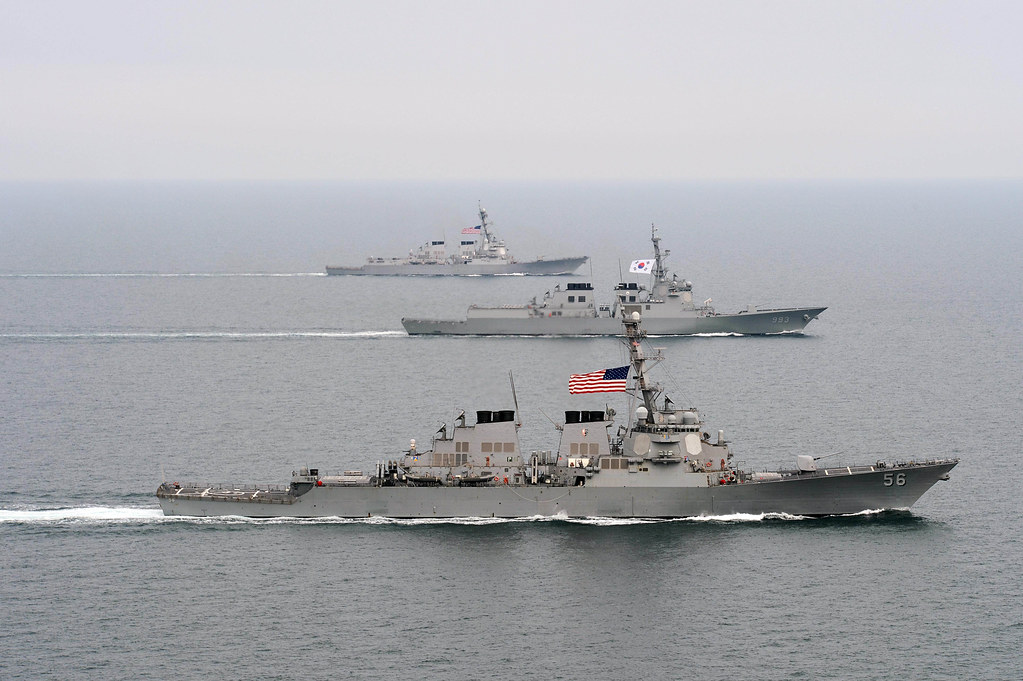 |
| Image: Flickr User - U.S. Pacific Fleet |
Brian Padden
WATERS TO THE WEST OF THE KOREAN PENINSULA (March 17, 2013) The guided-missile destroyer USS John S. McCain (DDG 56), front, the Republic of Korea Navy destroyer ROKS Seoae-Yu-Seong-Ryong (DDG 993), middle, and the guided-missile destroyer USS McCampbell (DDG 85) move into formation during exercise Foal Eagle 2013 (U.S. Navy photo by Mass Communication Specialist 3rd Class Declan Barnes/Released) >>
SEOUL — The United States and South Korea conducted naval exercises Monday as the potential for regional conflict is incrementally growing over North Korea’s advancing nuclear threat.
The USS Spruance, an American destroyer ship equipped for both anti-aircraft and anti-submarine warfare joined South Korean destroyers, submarines, anti-submarine helicopters and aircraft in a maritime operation on the East Sea, which is also called the Sea of Japan.
Admiral Brad Cooper, the commander of U.S. Naval Forces Korea said the joint naval drill was organized to showcase “the unwavering strength and resolve” of the American military allies “to defend against North Korea’s unprovoked acts of aggression.”
In the face of North Korea’s rapidly increasing nuclear and ballistic missile capabilities, Washington and Seoul are placing a greater emphasis on military readiness to prevent or respond to a possible attack.
Last week the U.S. temporarily deployed two B-1B bombers from Guam and flew the nuclear capable aircraft near the inter-Korean border.
Nuclear North
The Kim Jong Un government continued to flout a U.N. ban on its nuclear and missiles programs, and increased international sanctions imposed this year, by conducting a fifth nuclear test this month and numerous missile launches.
With each test North Korea comes closer to acquiring reliable and wide-ranging nuclear missile capabilities that could potentially strike targets in South Korea, Japan and the U.S. mainland.
At the United Nations last week North Korea Foreign Minister Ri Yong Ho said his country needed a nuclear deterrent of its own to defend against “the increased nuclear war threat of the United States.”
Military options
North Korea is building its nuclear weapons force while neglecting much of its conventional military capability, according to Victor Cha who holds the Korea chair at the Center for Strategic and International Studies and is director of Asian Studies at Georgetown University in Washington.
Writing in the South Korea newspaper the Korea Joongang Daily Monday, Cha argues that Pyongyang’s growing reliance on a nuclear deterrence is not “buying it more security. It is instead compelling the Unites States to consider military options.”
Cha says the U.S. and its allies must now assess whether the next North Korea long-range rocket launch is carrying a peaceful satellite or nuclear warhead, and consider launching a possible preemptive strike on the launch site or intercept the missile in flight.
Kim has ordered the military to prepare for another satellite launch as soon as possible and some speculate it could occur next month on the anniversary of the founding of the country’s Communist Party.
Under Kim Jong Un, North Korean provocations have not led to any deadly confrontations.
Northeast Asia analyst Daniel Pinkston with Troy University in Seoul says both sides understand that a nuclear attack would lead to a devastating war on the Korean Peninsula. But as tensions increase the risk that one side might launch a preemptive attack is a serious concern.
“If one or both sides reach a point where they believe conflict is unavoidable and inevitable, they have a very strong incentive to strike before the adversary,” said Pinkston.
Nuclear South?
In addition to deploying the U.S. THAAD missile defense system on the Korean Peninsula, more conservative members of Parliament in Seoul are calling for the South to develop its own nuclear tactical weapons.
Earlier this month 31 ruling Saenuri Party lawmakers released a statement calling for a parliamentary special committee to discuss South Korea's independent nuclear armament.
South Korean President Park Geun-hye, however, continues to support the current deterrence and containment regime that involves a close military alliance with the U.S. and increasing international pressure on the Kim Jong Un government.
This story first appeared on Voice of America & is reposted here with permission.
